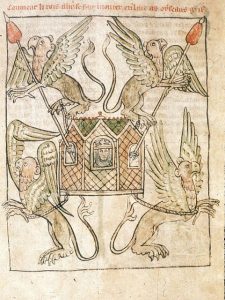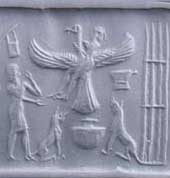Just for fun, as an appendix to the previous post, here are other stories of heroes being carried up into the heavens by eagles. Some appear to inspire aspirational thoughts of heavenly things while others warn of the hubris that felled Satan.
In that previous post I linked to (and briefly outlined) a story of Etana but for the sake of completeness let’s look at that starting point once more, this time with Aro’s description.
Akkadian Etana Myth
An eagle and a snake make a holy covenant that neither of them will harm the other. In spite of this, the eagle later devours the young of the snake and is punished by the Sun-God. Some kind of atonement is provided by the hero Etana who is looking for the “plant of birth” in order to obtain offspring. The eagle is willing to carry him to heaven upon its shoulders. The plan does not seem to lead to a successful completion, because Etana is frightened by the terrible height. He seems, however, to have obtained the plant, because other fragments of the epic presuppose that he sired a son. What interests us here is the idea of “space-travel” with an eagle and the conversation between Etana and the eagle:
The eagle says to him, to Etana:
“See, my friend, how the land appears!
Peer at the sea at the sides of E[kur]!”
“The land … a mountain,
the sea has become like waters of [. . . . ]”
When he had born him aloft a second league,
the eagle says to him, to Etana:
”See, my friend, how the land appears!”
“The land has turned to a gardener’s ditch.Etana and the eagle arrive at the heaven of Anu, and there is a break in the text; after that they presumably rise even higher. The conversation is continued on similar lines: e.g. the sea looks after one league’s flight like an enclosure, after two leagues the land is like a garden and the sea like a trough. At last Etana cannot see anything, and he is panicked: “My friend, I will not ascend to heaven.” The eagle descends with enormous speed to the ground.
(Aro, 25f)

Alexander the Great’s Ascent
From the origins of Sumerian civilization to the end of the Persian period, this tale must have been read and repeated throughout Western Asia. After the death of Alexander the Great, who had conquered and ruled Babylonia, it was transferred to him. The legend of the Ascension of Alexander spread throughout the ancient world and has descended to modern times in endless versions, Greek, Latin, Armenian, Coptic, Syriac, and Old French. Representations of Alexander’s ascent on eagles yoked together are found on tapestries, on illuminated manuscripts, painted on walls of palaces, and even in sculptures of Christian cathedrals. A Jewish scribe of the fourth century A.D. refers to it in the Talmud.
“Alexander the Macedonian wished to ascend in the air. He mounted, mounted, until he saw the earth as a cup and the sea as a caldron.”
Here follows a resume of the earliest Greek versions. Arrived at the extremity of the earth, Alexander desired to discover where the vault of Heaven reposed on the earth. His soldiers selected two great birds, which he caused to be without food for three days. He then put them under a yoke, and attached the hide of a bull to the yoke. A basket was fastened to the yoke, into which he climbed, having a long spear. To the end of this spear he attached the liver of a horse. The liver he held high above the heads of the hungry birds; in their eagerness to reach it they carried him upward. He ascended until the air became icy cold. Here he was halted by a bird-man who said to him:
“Alexander, thou art ignorant of terrestrial things, why desirest thou to understand those of Heaven? Return quickly to earth, and fear lest thou be the prey of these birds. Look upon the earth below.”
Seized with fear Alexander looked downward, and the earth looked like a threshing floor, surrounded by a serpent, which was the sea. He descended successfully “by the mercy of supreme Providence,” but landed seven days’ journey from his camp. Saved from famine by a satrap he received a guard of soldiers and reached his camp.
(Langdon, 173f)
Nimrod’s Ascent
In Islamic legends told by the commentators of the Qur’an, especially at-Tabar!, the same story is told about Nimrod (ar. Namrūd), and utilized to explain the words of Surah 14,46:
Continue reading “Carried to Heaven on Eagles’ Wings — More Tales”

